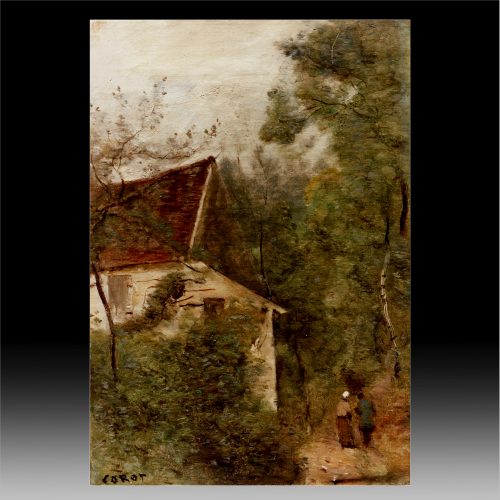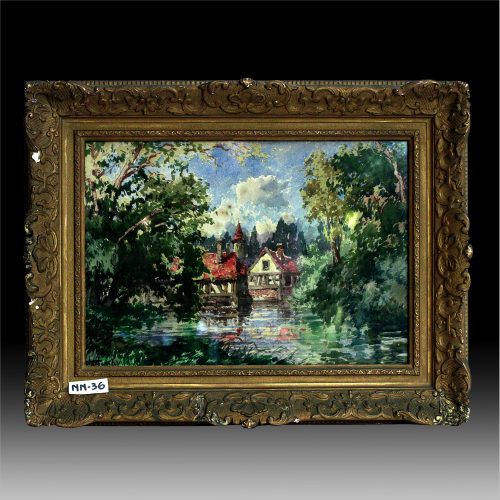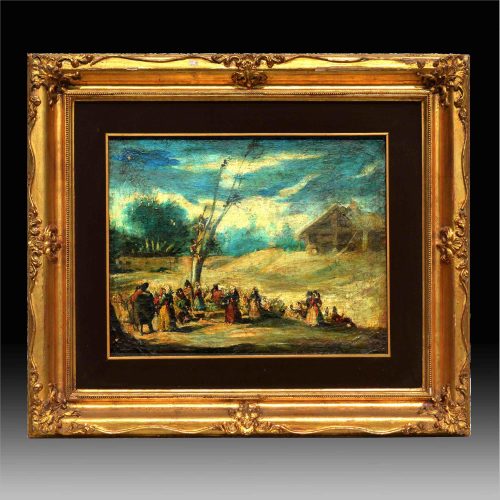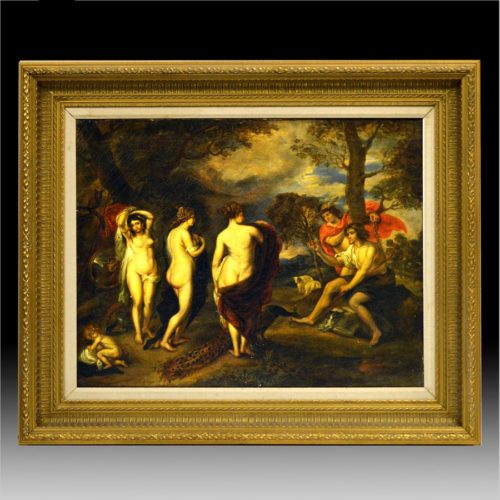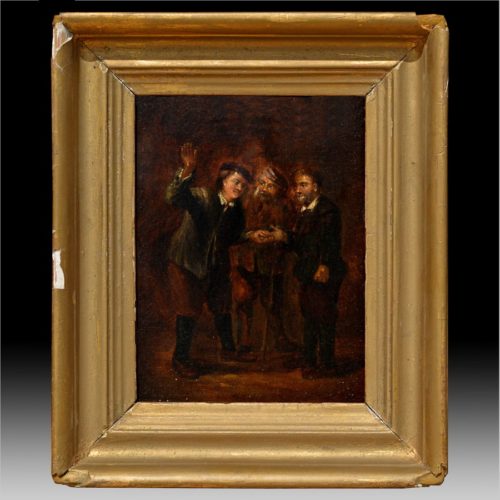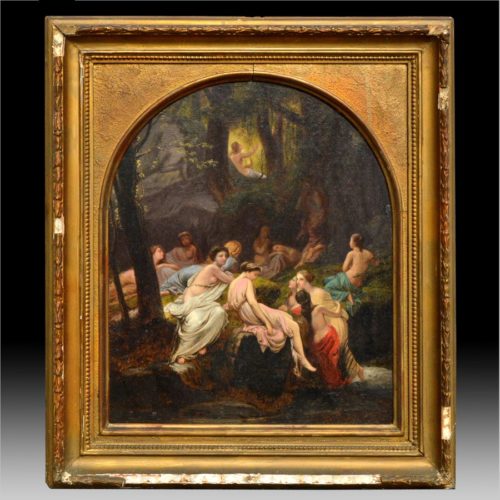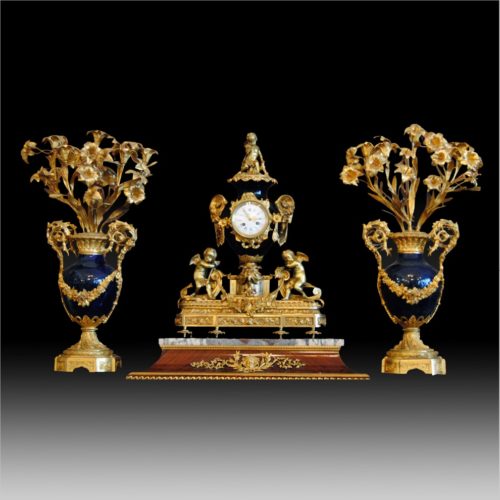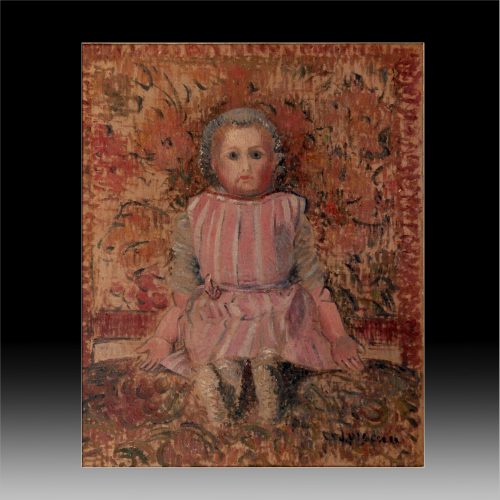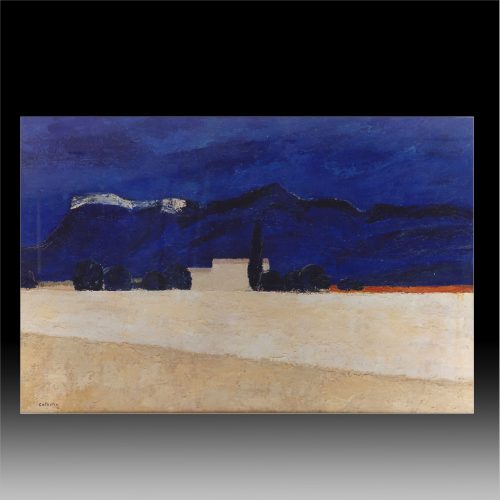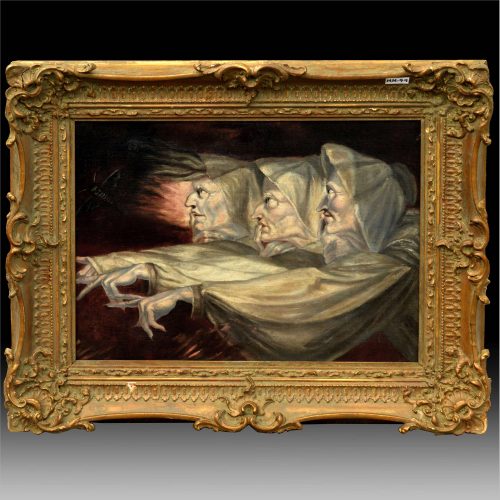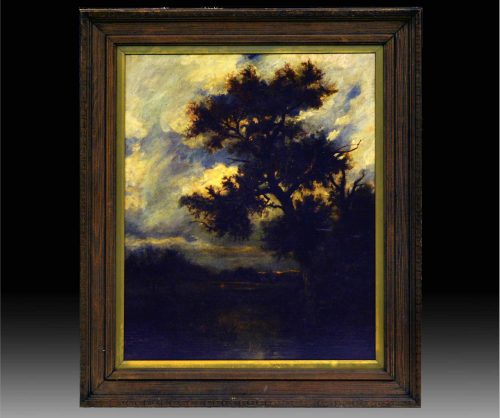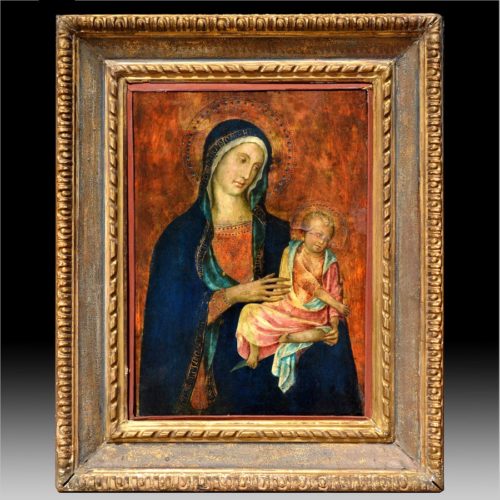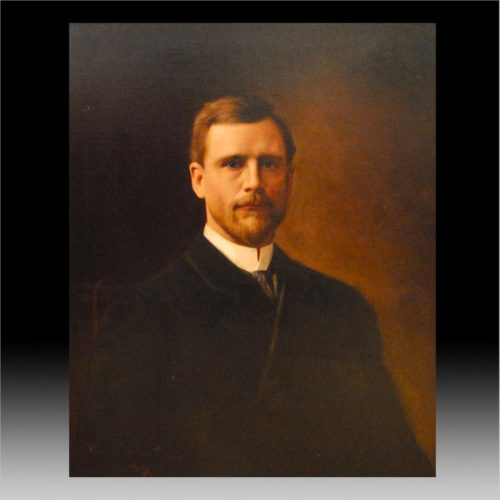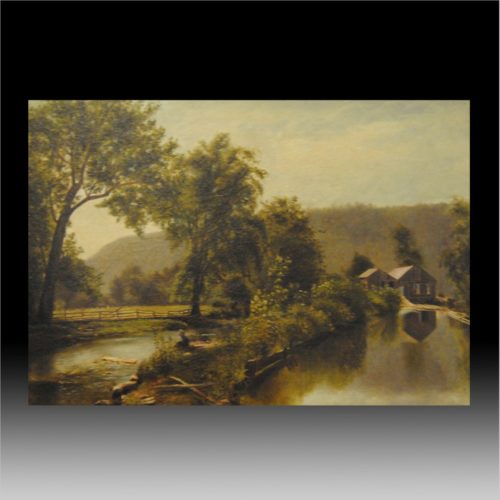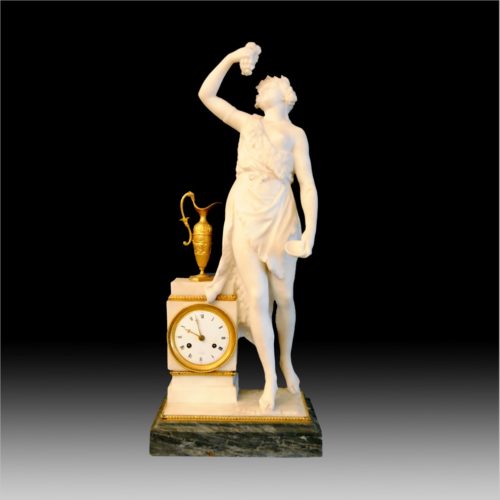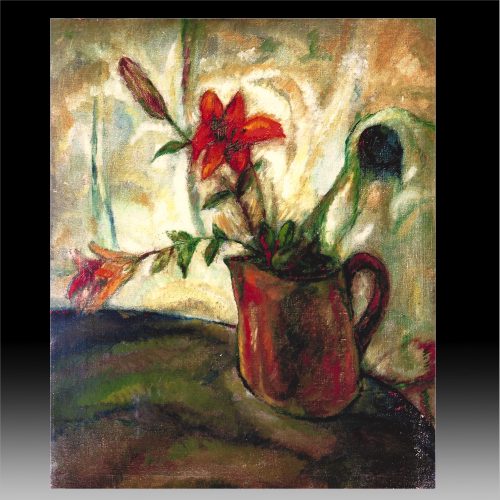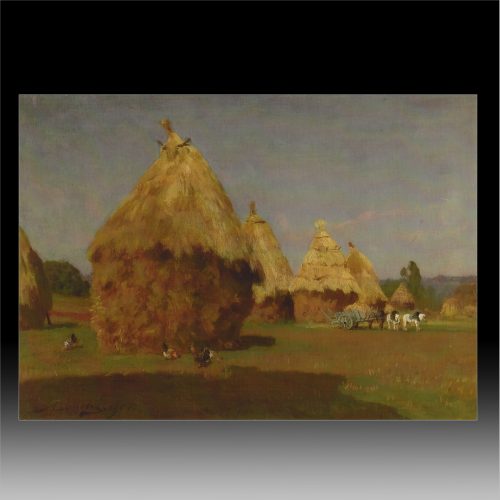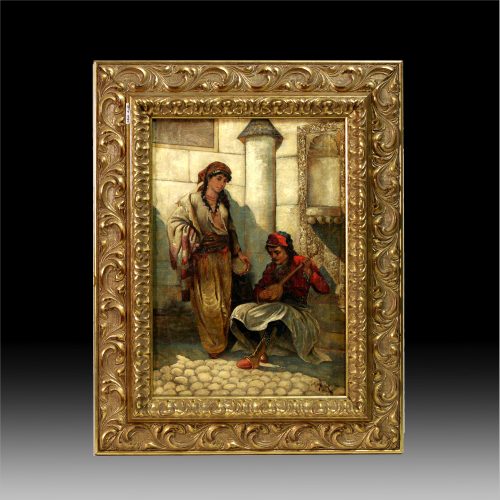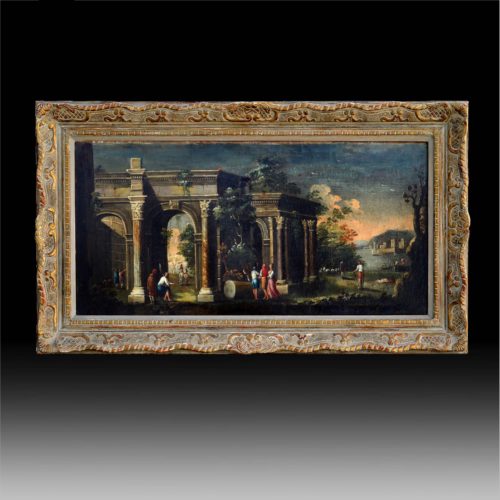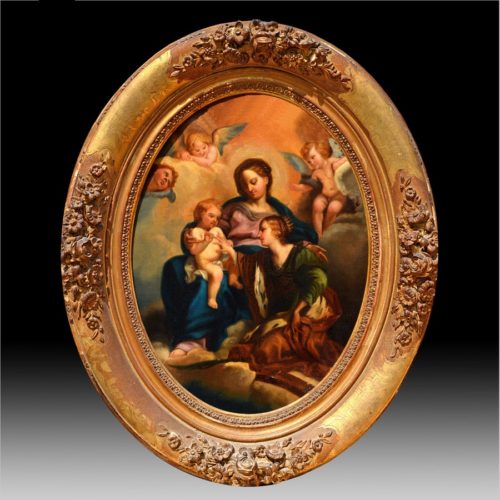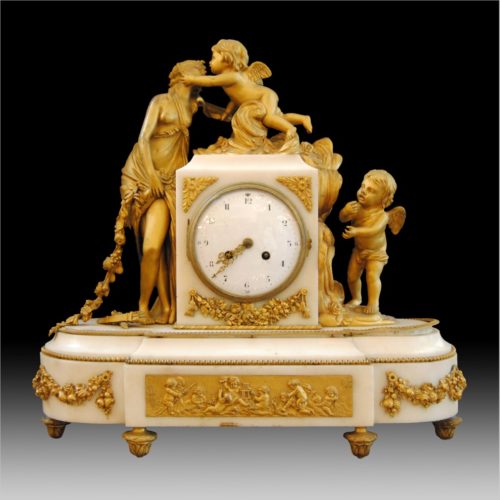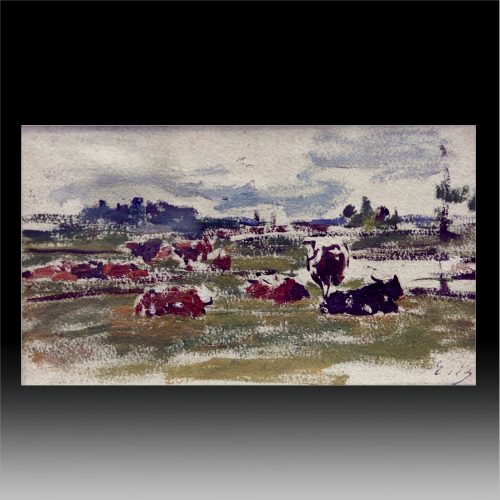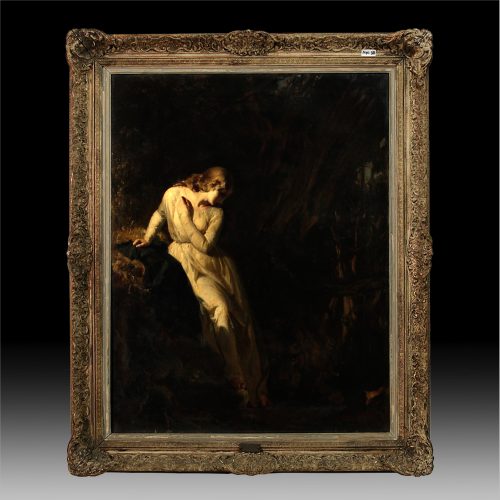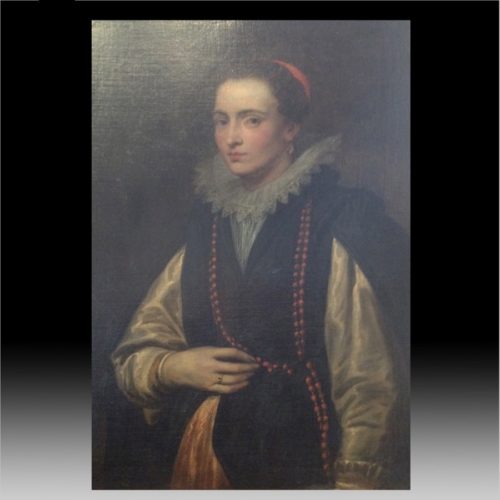View cart ““A Sevres-Style Clock with a pair of Five-Light Candelabra”” has been added to your cart.
-
Jean Baptiste
Camile Corot
(French, 1796-1875)
“Luzancy,
le chemin des bois”
Oil on canvas
13 ½” x 9 ½”
Signed lower left
Executed in 1872
COA by M. Dieterle
Depicted house “Maison Petre” belonged to an old friend of Corot, M. Remy.
PROVENANCE:
M. Ferret, Paris 1882
Aubin, Paris 1882
Hollander et Cremetti, London circa 1895
Galerie Le Roy, Brussels
Mr and Mrs. John Warner
With Wildenstein, NY
Salander-O’Reilly Galleries, NY
LITERATURE:
A. Robaut “L’Oeuvre de Corot”, Vol.I II, # 2087
-
Georges William Thornley
(British, b. 1857-1935)
‘The Watermill’
signed, watercolor on paper
11 x 15 ½ in. (27.9 x 39.4 cm)
Georges William Thornley (1857–1935) was a French painter and printmaker. A student of the French landscape painter Eugène Ciceri and Edmond Yon, Thornley became a successful artist remembered for his seascapes from Normandy and his landscapes from the French and Italian Rivieras. He was the son of a Welsh immigrant Morgan Thornley. He also was a talented watercolorist, engraver, and lithographer. His lithographs after the works of Corot, Pissarro, Degas and Puvis de Chavannes were acclaimed by his peers and awarded at the Salon de Paris.
His paintings were exhibited beginning in 1878. He won the Mention of Honor in 1881 and a Third Class medal in 1888. Thornley embraced the Impressionist movement early in his career, which brought him much success. His style characteristically has bold brushwork and thick "impasto." It recreates the "impression of a panorama", capturing the fleeting moment in its inner light and color. This open landscape is an example of what the artist excelled at: successful color effects which are highly decorative but stay true to nature.
-
Unknown Artist
19th Century
“A Gathering”
15 x 19 in.
-
Sirens and Seduction
Pair of Paintings
Provenance: France
AC. 28.000
@AL 7/13
-
David Teniers
‘The Palm Reader’
oil on panel
6 7/8 x 4 5/8 in.
(17.5 x 11.7 cm)
CL102794-253
39520-2
@AC-NB
-
Charles François Jalabert
Women in the Forest
Oil on canvas
Within a painted arch
39.4 x 31.8 cm
S71791-209
899001-3
-
Pair of Louis XVI Style Gilt-Bronze Mounted Porcelain Urn Form Candelabra, late 19th Century.
Height: 31 inches.
BBJUN2402-7362
AC11750
Made Set with Clock.
F-1068
-
Gustave Loiseau
(French, 1865-1935)
“La poupee”
Oil on canvas
21 ½”x 17 ½”
Signed lower right
Titled on reverse
Painted circa 1919
COA by Didier Imbert
-
Catalin Balescu
(Romanian, 1962)
“Landscape”
24”x 35”
Oil on canvas
Signed lower left
-
After Heinrich Fuseli
(Swiss, 1741-1825)
‘The Furies’
Oil on canvas
19 x 24 ½ in. (48.3 x 62.2 cm)
Provenance:
Mr. & Mrs. Peter P. Williams, Raleigh.
-
Artist Unknown,
19th Century
Landscape
-
Duccio di Buoninsegna (Italian, 1255-1318)
“The Madonna and Child”
Oil on panel
18 ½ x 13 inches
Duccio di Buoninsegna (Italian; c. 1255–1260 – c. 1318–1319) was an Italian painter active in Siena, Tuscany in the late 13th and early 14th centuries.
He is considered to be the father of Sienese painting and, along with a few others, the founder of Western art. He was hired throughout his life to complete many important works in government and religious buildings around Italy. Duccio is credited with creating the painting styles of Trecento and the Sienese school, and also contributed significantly to the Sienese Gothic style.
Although much is still unconfirmed about Duccio and his life, there is more documentation of him and his life than of other Italian painters of his time. It is known that he was born and died in the city of Siena, and was also mostly active in the surrounding region of Tuscany. Other details of his early life and family are as uncertain, as much else in his history. Nevertheless, his artistic talents were enough to overshadow his lack of organization as a citizen, and he became famous in his own lifetime. In the 14th century Duccio became one of the most favored and radical painters in Siena.
CL102794-10
561202-2
@NB-1040
#7
-
Walter Gilman Page
1862-1934
“Portrait of a gentlemen”
Oil on canvas
28 ½” x 36”
Signed and dated 1903 lower left
Worth 1500
@AC-NB
-
American School-
Artist: Unknown
“An Old canal”
20” x 14 ¼”
In 1870
@AC-NB
-
A Napoleon III Ormolu- Mounted Carrara Marble Figural Mantel Clock, circa 1870.
Modeled as scantily-clad baccante standing beside an ormolu ewer on a rectangular plinth, centered with an enameled dial inscribed […]/a Paris, the twin-train movement by JapyFreres, the movement door engraved to the reverse Repaired by/Blaine Jewelers/Newport R.I. / 9-29-54/11-1-61/9-13-77, on rectangular naturalistic base and bleu turquin marble plinth.
Height: 25 inches
CNYAPR2401-169
AC17000
F-798
-
Yasuo Kuniyoshi
(American, 1893-1953)
"Still life with flowers"
Oil on canvas
20”x 16”
Painted in 1920
COA by B. Usui
-
Arnulf De Bouche
(German, b.1872)
Haystacks
Signed and dated ‘Abouche.1901’ lower left
Oil on canvas
13x 18 in. (33 x 45.8 cm)
-
Aleksei Mikhailovich Korin
(Russian,1865-1923)
‘Street Musicians’
oil on canvas
20½” x 14 ½”
-
Antonio Joli (Italian, 1700-1777)
“Figures Amongst Classical Ruins”
Oil on canvas
15 ¼ x 30 ½ inches
(38.7 x 77.5 cm)
Antonio Joli or Ioli (1700 – 29 April 1777) was an Italian painter of vedute and capricci. Born in Modena, he first was apprenticed to Rafaello Rinaldi. He then studied in Rome under Giovanni Paolo Panini, and in the studios of the Galli da Bibbiena family of scene-painters. He became a painter of stage sets in Modena and Perugia. In 1732 he moved to Venice, where he worked as stage-painter for opera productions at the Teatro di San Giovanni Grisostomo and the Teatro San Samuele of the Grimani family. In 1742 he went to Dresden, and then to London (1744–48) and Madrid (1750–54).
-
Francesco Solimena (Italian, 1657-1747)
“The Mystic Marriage of Saint Catherine”
Oil on canvas, Oval
12 7/8 x 9 5/8 inches
(31.8 x 24.7 cm)
CL102794-97
430602-2
@NB-1040
#61
-
A Louis XVI Style Ormolu and White Marble Mantel Clock, circa 1880.
The enameled dial with twin-train movement, within a square marble case surmounted by Cupid and flanked by Venus and a cherub, above a relief-inset marble plinth and toupee feet, on a marble base.
Height: 19 inches
Width: 19 ½ inches
A pair of Louis XVI style ormolu and white marble figural six-light candelabra. Late 19th century.
Each modeled as aputto supporting a floral-garlanded vase issuing acanthus-sheathed scrolled branches, on laurel-cast base, shaped plinth and tapering foliate-cast feet, now mounted as lamps.
26 ¾ in. (67.8cm) high, excluding fitting.
CEMAR2701-100
AC15040
F-760
Candelabra:
CEMAR2701-124
AC11280
F-763
-
Eugéne Boudin
(French, 1824-1898)
“Vaches au paturage”
Oil on paper
4 ½” x 7 ¾”
Stamped with initials lower right
-
Circle of Alfred Elmore, R.A.
‘Una and The Lion’
oil on canvas.
36 x 28 in. (91.4 x 71.1 cm
-
Sir Anthony van Dyck
‘Portrait of the Marchesa Lomellini-Durazzo, three quarter length, in a black Coat and white Sleeves’
oil on canvas
33 5/8 x 24 in.
85.4 x 61 cm.
CL102794-266
5115602-2
@AC-sAlbert.

